
Kuching, officially the City of Kuching, is the capital and the most populous city in the state of Sarawak in Malaysia. It is also the capital of Kuching Division. The city is on the Sarawak River at the southwest tip of the state of Sarawak on the island of Borneo and covers an area of 431 km2 (166 sq mi) with a population about 165,642 in the Kuching North administrative region and 159,490 in the Kuching South administrative region—a total of 325,132 people.

Sibu is a landlocked city located in the central region of Sarawak, Malaysia. It serves as the capital of Sibu District within Sibu Division and is situated on the island of Borneo. Covering an area of 129.5 square kilometres (50.0 sq mi), the city is positioned at the confluence of the Rajang and Igan Rivers, approximately 60 kilometres from the South China Sea and 191.5 kilometres (119 mi) north-east of the state capital, Kuching.

Sarikei is a town, and the capital of Sarikei District in Sarikei Division, Sarawak, Malaysia. It is located on the Rajang River, near where the river empties into the South China Sea. The district population was 56,798.

Chinatown is a subzone and ethnic enclave located within the Outram district in the Central Area of Singapore. Featuring distinctly Chinese cultural elements, Chinatown has had a historically concentrated ethnic Chinese population.

Lim Chu Kang is a planning area located in the northwestern part of the North Region of Singapore, bordering the Western Water Catchment to the west and south, Sungei Kadut to the east and the Straits of Johor to the north.

Petaling Street is a Chinatown located in Kuala Lumpur, Malaysia. The whole vicinity is also known as Chinatown KL. Haggling is a common sight here and the place is usually crowded with locals as well as tourists.
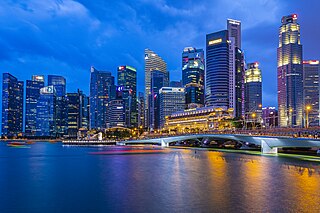
The Central Area, also called the City Area, and informally The City, is the main commercial city centre of Singapore. Located in the south-eastern part of the Central Region, the Central Area consists of eleven constituent planning areas: the Downtown Core, Marina East, Marina South, the Museum Planning Area, Newton, Orchard, Outram, River Valley, Rochor, the Singapore River and Straits View, as defined by the Urban Redevelopment Authority. The term Central Business District (CBD) has also been used to describe most of the Central Area as well, although its boundaries lie within the Downtown Core.
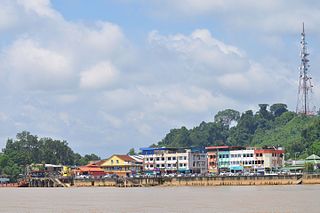
Kanowit is a town and the capital of Kanowit District, Sibu Division, Sarawak, Malaysia, comprising 2,253.5 square kilometres. As of 2010, Kanowit's population is 28,985. It is built on the mouth of Kanowit River at the bank of Rajang River, approximately 174 kilometers from the coast of South China Sea. It takes 45 minutes to reach the town by land transport and an hour by boat from Sibu. The main ethnic groups are Iban, Chinese, Malay, and Melanau.
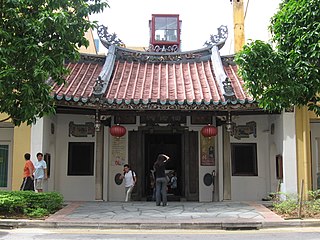
The Fuk Tak Chi Temple or Fook Tet Soo Khek Temple was one of the oldest former temple in Singapore built in 1820 by Cantonese and Hakka immigrants from Kwong Wai Siew (广惠肇三府). It is currently a museum housing more than 200 artefacts.
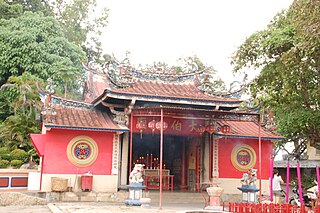
Tua Pek Kong is a Taoist deity in the pantheon of Peranakan folk religion practiced by ethnic Chinese in Malaysia, Singapore, and parts of Indonesia.
Tan Sri Datuk Amar Ong Kee Hui was a Malaysian Chinese politician and founder cum first president of the Sarawak United People's Party which was founded on 12 June 1959. His family trace their origins to Longhai, Zhangzhou, Fujian Province, China.
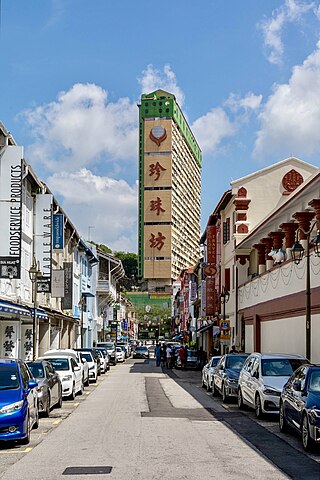
Temple Street is a one-way street in Chinatown within the Outram Planning Area in Singapore. The road links South Bridge Road to New Bridge Road, and is intersected by Trengganu Street.

Balestier is a sub zone located in the planning area of Novena in the Central Region of Singapore. The main road, Balestier Road, links Thomson Road to Serangoon Road and the road continues on as Lavender Street. The area is home to rows of shophouses, such as the Sim Kwong Ho shophouses, the Balestier Art Deco shophouses, 412-418 Balestier Road, and 601-639 Balestier Road, low-rise apartments and commercial buildings as well as a shopping mall known as Shaw Plaza. Balestier also has another mall, Zhongshan Mall. There are several lighting and electrical shops along Balestier Road, which is also home to the Ceylon Sports Club and the Indian Association. The area is known for its food such as bak kut teh and chicken rice. In the area, there are several apartments, condominiums, and budget hotels.

Kuching High School, officially Kuching High National-type Secondary School, is a public secondary school in Kuching, the capital of the Malaysian state of Sarawak. The school provides secondary education from Transition to Form 5, which culminates in the sitting of the public examinations of Form Three Assessment in Form 3 and the Malaysian Certificate of Education in Form 5. The school was founded in 1916 as a Chinese private school and from 1963 until today it became a Government-aided school.

Kampung Cina, is a Chinatown located in Kuala Terengganu, Terengganu, Malaysia. Kampung Cina is located along Jalan Bandar, in Kuala Terengganu city centre at the river mouth of Terengganu River that empties into the South China Sea. Kampung Cina literally means Chinese Village; it is also called Tn̂g-lâng-pho (唐人坡) or KT's Chinatown by local people. It is one of Southeast Asia's early Chinese settlements and contains stately ancestral homes, temples, townhouses, and business establishments. The town is small but has colourful shophouses along both sides of the road that carries traditional flavour.
Kapitan China Ong Tiang Swee,, CSS known as the Grand Old Man, was a renowned businessman and philanthropist in Sarawak. Regarded as the most prominent and successful Chinese community leader in Sarawak, he was Kapitan China of Sarawak and President of the Chinese Chamber of Commerce, as well as an advisor on Chinese Affairs and confidant to Rajah Charles Brooke. He was also the first Chinese nominated to the Sarawak Council Negri in 1937. He played a significant role in the progress of the state and saw Sarawak through its infant stages of development.

Hong San Si Temple is a Chinese temple situated in Carpenter Street of Kuching, Sarawak, Malaysia. It is part of the Kuching Heritage Trail.
Kapitan China Ong Kwan Hin (1896-1982) was a prominent businessman and community leader in Sarawak.

Kapitan China Ong Ewe Hai (1830–1888), was a prominent businessman and community leader in Sarawak.






















